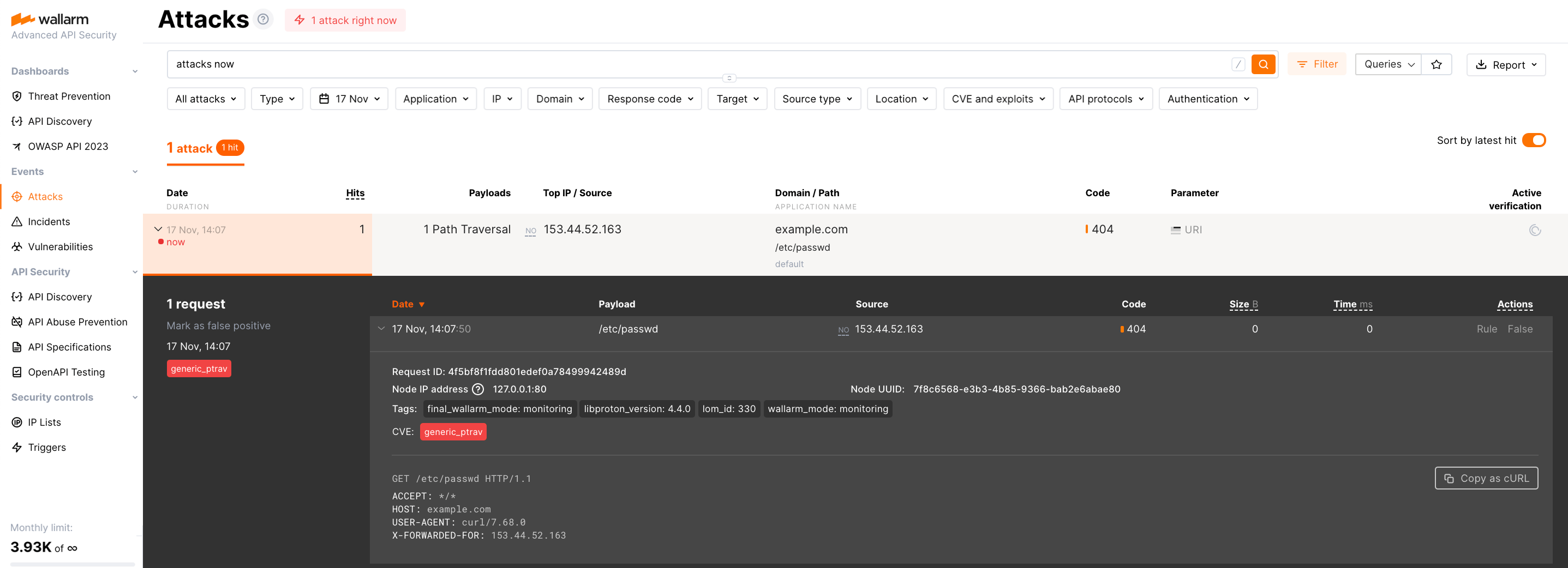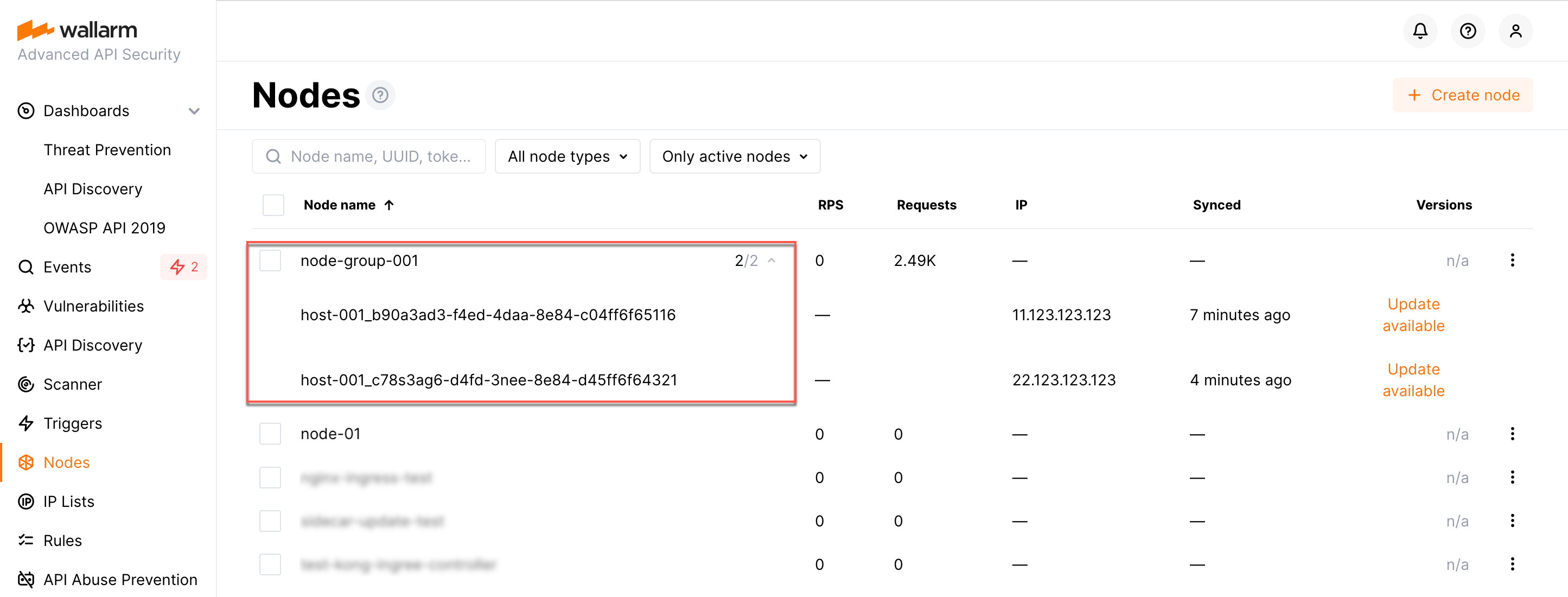نشر Wallarm OOB من صورة أمازون¶
توفر هذه المقالة التعليمات لنشر Wallarm OOB على AWS باستخدام الصورة الرسمية لآلة أمازون (AMI). الحل الموصوف هنا مصمم لتحليل حركة المرور المعكوسة بواسطة الويب أو خادم الوكيل.
حالات الاستخدام¶
Among all supported Wallarm deployment options, AMI is recommended for Wallarm deployment in these use cases:
-
Your existing infrastructure resides on AWS.
-
You aim to deploy a security solution as a separate cloud instance, rather than installing it directly on frontend systems like NGINX.
Requirements¶
-
An AWS account
-
Understanding of AWS EC2, Security Groups
-
Any AWS region of your choice, there are no specific restrictions on the region for the Wallarm node deployment
Wallarm supports both single availability zone (AZ) and multi availability zone deployments. In multi-AZ setups, Wallarm Nodes can be launched in separate availability zones and placed behind a Load Balancer for high availability.
-
Access to the account with the Administrator role in Wallarm Console for the US Cloud or EU Cloud
-
Executing all commands on a Wallarm instance as a superuser (e.g.
root)
Installation¶
1. Launch a Wallarm Node instance¶
Launch an EC2 instance using the Wallarm NGINX Node AMI.
Recommended configuration:
-
Latest available [AMI version][latest-node-version]
-
Any preferred AWS region
-
EC2 instance type:
t3.medium(for testing) orm4.xlarge(for production), [see cost guidance for details][aws-costs] -
SSH key pair for accessing the instance
-
Appropriate VPC and subnet based on your infrastructure
-
Security Group inbound access to ports 22, 80, and 443
Using a security group preconfigured by Wallarm
When you deploy the instance and create a security group, AWS prompts you to use the one preconfigured by Wallarm. This group already has all the necessary ports open for inbound access.
![!Preconfigured security group][img-security-group]
-
Security Group outbound access to:
https://meganode.wallarm.comto download the Wallarm installerhttps://us1.api.wallarm.comfor working with US Wallarm Cloud or tohttps://api.wallarm.comfor working with EU Wallarm Cloud. If access can be configured only via the proxy server, then use the instructions-
IP addresses below for downloading updates to attack detection rules and [API specifications][api-spec-enforcement-docs], as well as retrieving precise IPs for your [allowlisted, denylisted, or graylisted][ip-lists-docs] countries, regions, or data centers
2. Connect to the Wallarm Node instance via SSH¶
Use the selected SSH key to connect to your running EC2 instance:
You need to use the admin username to connect to the instance.
3. Generate a token to connect an instance to the Wallarm Cloud¶
The Wallarm node needs to connect to the Wallarm Cloud using a Wallarm token of the appropriate type. An API token allows you to create a node group in the Wallarm Console UI, helping you organize your node instances more effectively.
Generate a token as follows:
6. الاتصال بالنسخة السحابية من Wallarm¶
يتصل عقدة النسخة السحابية بالسحابة من Wallarm عبر السكربت cloud-init.py. يقوم هذا السكريبت بتسجيل العقدة مع السحابة من Wallarm باستخدام الرمز المقدم، ويعمل على تحديدها عالميًا إلى وضع المراقبة، ويقوم بتعيين الأوامر wallarm_force في كتلة location / في NGINX لتحليل نسخ حركة المرور المعكوسة فقط. إعادة تشغيل NGINX تنهي الإعداد.
قم بتشغيل السكريبت cloud-init.py على النسخة المنشأة من الصورة السحابية كما يلي:
-
WALLARM_LABELS='group=<GROUP>'يحدد اسم مجموعة العقدة (موجودة، أو، إذا لم تكن موجودة، سيتم إنشاؤها). يتم تطبيقه فقط إذا كان يستخدم رمز API. -
<TOKEN>هو القيمة المنسوخة للرمز.
7. تكوين الويب أو خادم الوكيل لعكس حركة المرور إلى عقدة Wallarm¶
- قم بتكوين خادم الويب أو الوكيل (مثلاً NGINX، Envoy) لعكس حركة المرور الواردة إلى عقدة Wallarm. للحصول على تفاصيل التكوين، نوصي بالرجوع إلى دليل خادم الويب أو الوكيل.
داخل [الرابط][web-server-mirroring-examples]، ستجد التكوين المثالي لأشهر خوادم الويب والوكلاء (NGINX، Traefik، Envoy).
-
قم بتعيين التكوين التالي في ملف
/etc/nginx/sites-enabled/defaultعلى النسخة بالعقدة:location / { include /etc/nginx/presets.d/mirror.conf; # قم بتغيير 222.222.222.22 إلى عنوان خادم العكس set_real_ip_from 222.222.222.22; real_ip_header X-Forwarded-For; }أوامر
set_real_ip_fromوreal_ip_headerمطلوبة لعرض عناوين IP للمخترقين في وحدة تحكم Wallarm.
8. اختبار تشغيل Wallarm¶
-
The request with test Path Traversal attack to an address of either the web or proxy server mirroring traffic or the machine with the Wallarm node:
-
Open Wallarm Console → Attacks section in the US Cloud or EU Cloud and make sure the attack is displayed in the list.

Since Wallarm OOB operates in the monitoring mode, the Wallarm node does not block the attack but registers it.
9. ضبط الحل المنشور¶
The deployment is now complete. The filtering node may require some additional configuration after deployment.
Wallarm settings are defined using the NGINX directives or the Wallarm Console UI. Directives should be set in the following files on the Wallarm instance:
-
/etc/nginx/sites-enabled/defaultdefines the configuration of NGINX -
/etc/nginx/conf.d/wallarm.confdefines the global configuration of Wallarm filtering node -
/etc/nginx/conf.d/wallarm-status.confdefines the filtering node monitoring service configuration -
/opt/wallarm/wstore/wstore.yamlwith the postanalytics service (wstore) settings
You can modify the listed files or create your own configuration files to define the operation of NGINX and Wallarm. It is recommended to create a separate configuration file with the server block for each group of the domains that should be processed in the same way (e.g. example.com.conf). To see detailed information about working with NGINX configuration files, proceed to the official NGINX documentation.
Creating a configuration file
When creating a custom configuration file, make sure that NGINX listens to the incoming connections on the free port.
Below there are a few of the typical settings that you can apply if needed:
To apply the settings, restart NGINX on the Wallarm instance:
Each configuration file change requires NGINX to be restarted to apply it.
